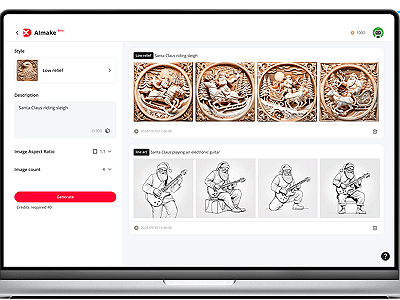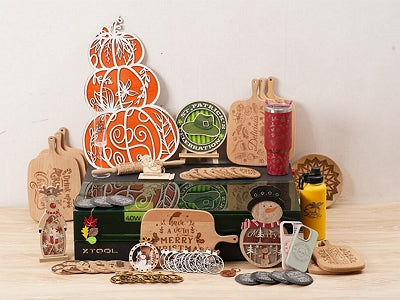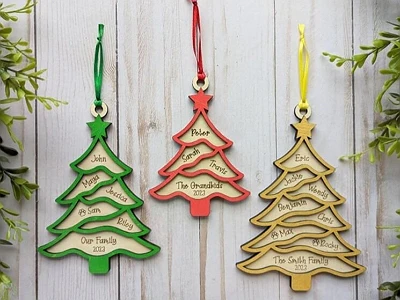Art is a multi-billion-dollar industry. Billions of dollars have been exchanging hands in the art market for the past few years, and it's not slowing down anytime soon. Art sellers and buyers are the two major pieces that have contributed to the booming industry. Interestingly, starting an art business is not rocket science — and any skilled art maker can start one, and profit from the growing industry.
Art lovers who would want to start a business around their skills and passion may feel overwhelmed. Such a feeling is expected, but with the right information, you will see that starting an art business is not as difficult as it sounds. The first thing needed is the ability to produce high-quality artwork — and that involves using good equipment like laser engraving and cutting machines.
The accuracy and precision that comes with using laser engraving and cutting machines are unmatched. It's the best fit for artmakers who will be designing very complex artwork. The best part, these machines are affordable and easy to maintain.
After getting your tools, and creating some beautiful pieces of artwork (more on this later), the next thing is starting a profitable art business by following these nine simple steps.
In This Article
- Step 1: Finding Your Niche
- Step 2: Decide Where to Sell Your Artwork
- Step 3: Write Your Art Business Plan
- Step 4: Choose Your Art Business Name
- Step 5: Obtain the Necessary Licenses, Permits, and Insurance
- Step 6: Create Your Artwork
- Step 7: Price Your Artwork
- Step 8: Marketing Your Masterpieces
- Step 9: Start Selling Your Art Online
Step 1: Finding Your Niche
Finding a niche could be the key to building a passionate community of loyal paying customers. To find your niche, you need to explore the kind of arts you're passionate about. What art styles, techniques, and subjects appeal the most to you? Do you gravitate towards a specific kind of artwork? You need to do some introspection to figure out what your artistic strengths and weaknesses are. After that, do some market research.
Market research could involve studying trends analysis, and your target audience. What are the current trends in the industry, and what art style resonates the most with the audiences? You also need to have a good grasp of the various art that sells. Furthermore, you need to figure out who your customer avatar is. What are their buying habits, demographics, and interests?
Answers to your findings should give you a clue of what your niche is. Your ideal niche should be an intersection between your artistic skills, market demand, and passion.
Don't shy away from being specific. Starting an art business around pet portraits is far better than a business around just portraits. Finally, you have to be sure that there are enough potential customers available to buy art items in your niche.
Hint: Here are the 10 profitable art business ideas you should consider.
Step 2: Decide Where to Sell Your Artwork
After coming up with a niche, you need to decide where to sell your artwork. And that involves knowing where to sell art online, offline, or both.
Selling offline involves setting up a physical store or showcasing your artwork at shows or fairs. It involves putting the right things in place — things that will help you sell art locally.
To properly figure out where to sell your artwork, you need to take these factors into consideration:
- Your art style and price point: What kind of art are you creating, and what's the price range of your art? For instance, premium artwork should not be sold at a basement sale of a small church. After all, people who come to buy art in those places are not looking for high-end artworks.
- Your target audience: You need to know who your target audience is, and come up with ways of displaying your artwork on the platforms they frequent regularly.
Speaking of displaying your artwork on platforms, you should consider online marketplaces like Etsy, or eBay. You could also opt to display your artwork on your social media platforms, your website, or in local art fairs and galleries.
Step 3: Write Your Art Business Plan
Your art business plan serves as the roadmap that guides you through the process of establishing and maintaining a profitable art business. The business plan has to be concise and focused. Always use professional and clear language during the writing process. Avoid jargon and unnecessary technical terms. Every claim has to be backed up with research and data to boost the credibility of the business plan. As your art business grows, you need to update the business plan to reflect the growth of the business.
But what makes up the business plan? The business plan should include vital pieces like:
- Executive summary
- Business description
- Market analysis
- Marketing and Sales strategy
- Operational plan
- Management team
- Financial projections
- Risk assessment
In the executive business, you will have to introduce your art business, showcase your unique selling proposition (USP), and give a summary of your business goals and financial projections.
The business description, market analysis, marketing and sales strategy pretty much involve listing out the regular business operations, who your target audience is, and how you will generate leads and sales for the art business.
In the operational plan and management team sections, you will have to show what your production process and workspace look like. You also have to show who your team members are (if you have any). If you'll be managing the art business all by yourself, then you'll have to clearly introduce yourself, and highlight your skills and experience in the management team section.
Finally, you need to show the financial projections of the business. Aside from that, you also need to write down ways you'll manage business risk.
Writing the art business plan shouldn't be a complex process. You can get started with a simple business plan, and keep adjusting it as your business grows.
Step 4: Choose Your Art Business Name
As a general rule, you should aim for about two to three words when choosing your art business name. Always avoid complicated names that might be hard to recall. Simply put, your art business name should be sweet, short, and memorable.
Your business name should reflect what you're selling and also appeal to your target audience. For instance, if you're selling to the younger Gen Z, your art business name should resonate with them, and there's nothing wrong with incorporating one or two slang into your art business name.
If you're unsure of how to get started, you will have to consider any of these art business name ideas.
After coming up with a business name, you will have to check for its availability. You can do that by going through the list of business names on your local directorate website. You can also do a quick Google search to see if the business name is available for use.
Finally, you need to say the business name out loud to ascertain that it flows naturally.
Step 5: Obtain the Necessary Licenses, Permits, and Insurance
Licenses, permits, and insurance protect you from legal risks. And the requirements for obtaining a license or permit are dependent on your art business structure, and location. Here are the various licenses, and permits you will need for your art business.
- Basic business license: Regardless of where you reside, you will need a basic business license. The license offers you the freedom to conduct your art business under your registered name.
- Sales tax permit: If your artworks are sold directly to the customers, a sales tax permit is needed for remitting sales taxes.
- Resale permit: This is an optional license, and it's for artists who buy finished artwork wholesale for resale. The resale permit helps eliminate double taxation on your sales tax.
- Home-based business permit: It's also an optional license and a great fit for artists who are considering starting their art business from the comfort of their homes.
The major insurance that should be obtained for your art business are:
- General liability insurance: This insurance protects your art business from financial losses that may be due to lawsuits, property damage, or bodily injury.
- Professional liability insurance: Professional liability insurance protects your art business from claims of errors or negligence. Getting this insurance is optional.
- Workers' compensation insurance: If there are employees to help you manage the daily operations of your art business, then you should consider getting workers' compensation insurance. The insurance covers the medical expenses of your employees. It also covers lost wages (in cases where the employee sustains work-related injuries).
To find the requirements needed for obtaining the necessary permits and licenses, you should consider looking into your local and state government websites. These websites should show you how you go about getting the licenses, permits, and insurance needed for the operation of an art business within the region.
Artists resident in the United States should consider looking into the Small Business Administration (SBA) website. The local chambers of commerce are another place that offers direction on how to go about obtaining the necessary license and permit for your art business.
Finally, you will need the services of a lawyer to help you navigate through the process.
Step 6: Create Your Artwork
At this point, you will have to roll up your sleeves and get to work! Creating your artwork involves using the right tools — and that's where laser machines come in. Laser machines are versatile tools with unmatched accuracy. They're built with incredible precision and can be used for creating artwork with delicate patterns and intricate details.
Laser machines can be used to work on a wide range of materials — and that makes it a good fit for art makers who will be producing artworks using materials like acrylic, fabric, wood, and anything in-between. Batch production is also possible with laser machines. These machines can produce multiple variations (or copies) of an artwork without a reduction in quality.

Customization and personalization of your artwork are also possible with laser machines. Unlike manual and traditional methods that take lots of time for the completion of complex tasks, laser machines are more efficient — and a fraction of the time is needed when working with these tools.
Step 7: Price Your Artwork
Pricing artwork is not an easy process. But it's one of the major things that establishes you as a professional artist in the industry. If you're uncertain of how to price your art, here are some factors you need to consider.
Direct costs: Direct costs involve studio expenses, material costs, and time and labor. For studio expenses, you have to consider utilities, rent, and overhead costs. This cost typically revolves around the studio space used for the production process. Material costs involve calculating the cost of production materials. These materials could be canvas, paint, or wood. You also need to put the time used for your art production into consideration. Hourly rate should be assigned to the time to get the monetary value of the production time.
Indirect costs: These include costs for business expenses, and marketing and promotion costs. Business expenses include fees for accounting services, legal fees, and other costs relevant to the business. Marketing and promotion costs include the cost of social media promotion, advertising, website maintenance (if you have one), and so on.
Both the direct and indirect costs should be factored in before putting a price tag on your artwork. If not, you will sell your artwork at a loss.
Furthermore, you need to look out for the perceived market value of your artwork. To do that, research the prices of artworks that are similar to yours. You need to figure out if these similar artworks are produced by more established and reputable artists. Reputable artists already have a buying community, and they're more likely to charge higher prices for their artwork.
The location of your target audience also plays a role in determining the price of your artwork. Buyers from certain demographics will likely pay more for artwork than other buyers.
Finally, you need to come up with a pricing strategy. You could consider cost-based, value-based, or market-based pricing. With cost-based pricing, the prices of your artwork are determined by the production costs — direct and indirect costs. Value-based pricing focuses on the perceived value of the artwork. And the prices are based on your skill level, and the perceived uniqueness of your artwork. In market-based pricing, prices of the artwork are adjusted to align with prices of similar artwork in the market.
The price of your artwork should be a reflection of the time and effort put into the production of the artwork. Confidently put a fair price tag on your item.
Step 8: Marketing Your Masterpieces
Marketing your masterpieces involves connecting your target audience to your business, and subsequently selling your artwork to them. To do that, you have to:
- Have a strong online presence: This involves creating a sleek website where you display your portfolio, having engaging social media accounts, taking advantage of online art marketplaces, and possibly starting a blog.
- Prioritize offline networking and marketing: Always participate in exhibitions, and art fairs, and connect with other artists. These offline interactions will come in handy in the future.
- Take advantage of paid advertising and promotion: Online ads like Google and Facebook Ads are sure ways of reaching your target audience across the globe. By merely optimizing your ad targeting options, you will be able to place your products in front of the right people. Aside from online ads, you should consider collaborating with influencers. A single promotional content from the right influencer is sure to generate leads and sales for your art business.
Step 9: Start Selling Your Art Online
Selling art online is a rewarding way of reaching new people and growing a profitable art business. Here are easy steps to help you start selling art online.
- Choose a platform: You can either opt for online marketplaces like Etsy or focus on social media platforms. Alternatively, there's the option of building a sleek website for your business or using online galleries.
- Set up an online shop: To get the most out of your online shop, you need to take stunning photos (or videos) of your art and upload them onto the shop. Every piece of art on the online shop should come with a compelling description, and the prices should be properly written. You need to be transparent about your return policies and shipping processes.
- Use social proof to build trust: Social proofs like reviews and testimonials are reliable ways of building trust online. Always showcase the positive feedback you receive from previously satisfied customers.
Conclusion
Starting an art business is not an entirely easy process — but it's worth every ounce of effort put into it! Art lovers who are looking to profit from their passion can start by finding the right niche. And your niche should be an intersection between the type of artwork you love producing, and what the target audience wants.
There's no fixed starting capital for an art business. However, you will need to come up with the amount needed for the business registration fee. You also need to come up with a budget for your production materials.
Newbies in the industry should focus on finding paying customers. And that involves doubling down on the sales and marketing efforts. Pricing an artwork is a complex process, and by following the instructions in this guide, you will figure out how to price your art.
Now you know how to start an art business, what niche will you be focusing on?




